Report on Contemporary Issues in International Management Analysis
VerifiedAdded on 2022/09/09
|16
|5862
|17
Report
AI Summary
This report delves into contemporary issues within international management, examining the impact of the global political economy, national socio-political dynamics, and the challenges of differentiation and organizational design. It explores the importance of responding to customer desires, addressing client needs effectively, and navigating cultural complexities. The analysis draws upon a Harvard Business Review article and considers the evolving landscape of international business, including the role of technology, and the impact of globalization. The report also discusses the significance of social economy and the role of organizations in the context of global competition, and provides examples such as the use of MagicBands by Disney and technology in healthcare. The conclusion summarizes the key findings and the importance of adapting to the changing global environment.
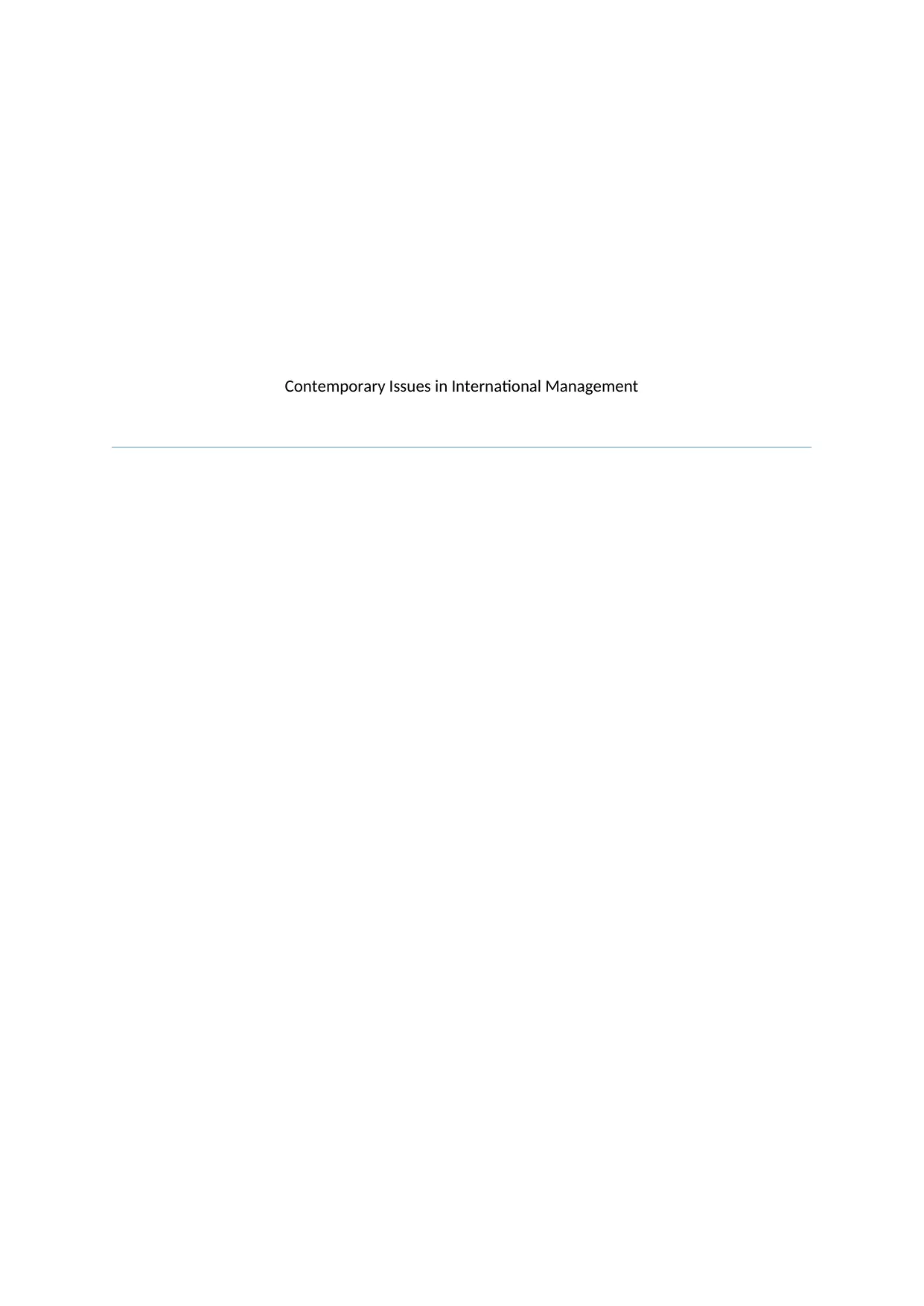
Contemporary Issues in International Management
Paraphrase This Document
Need a fresh take? Get an instant paraphrase of this document with our AI Paraphraser
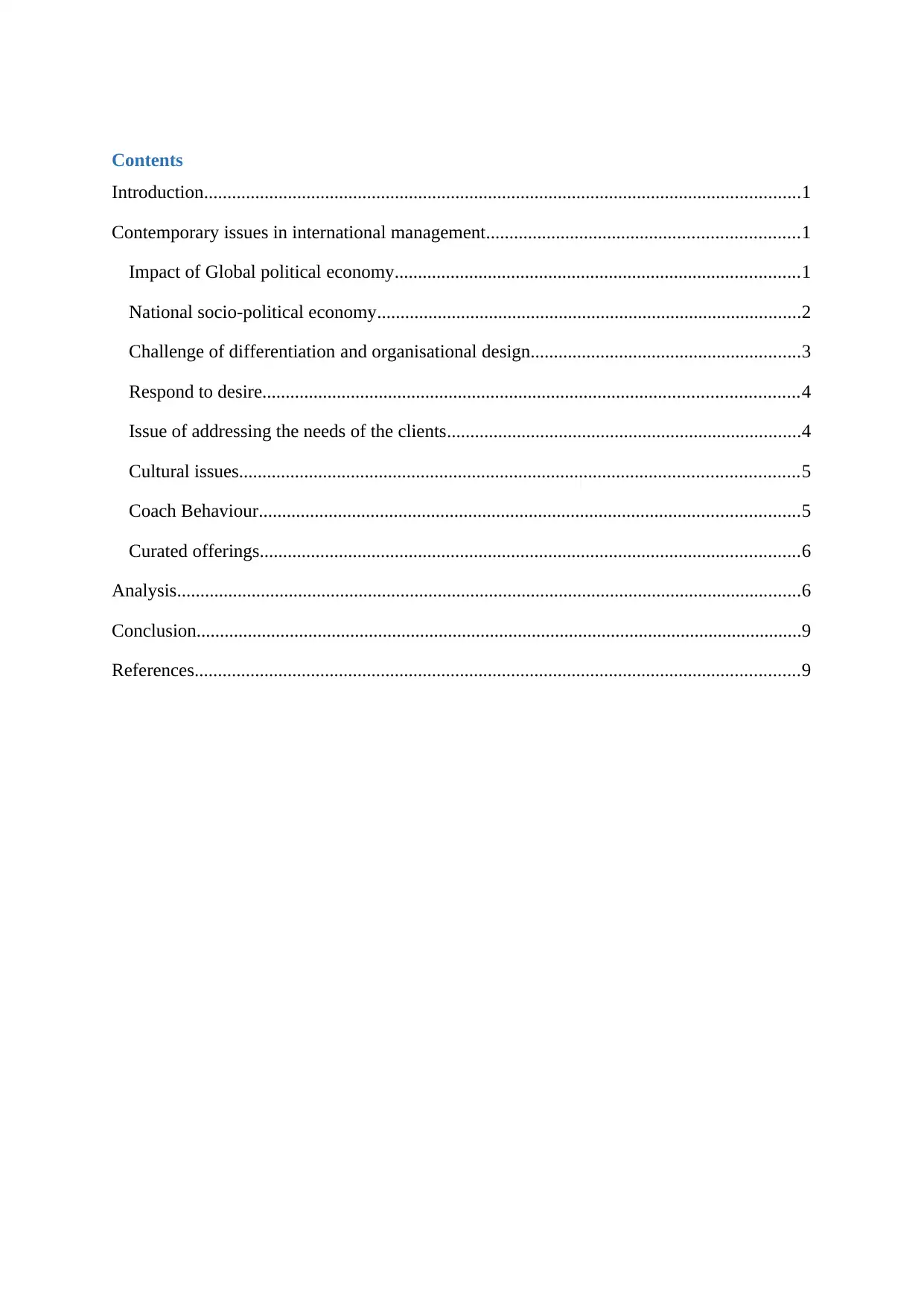
Contents
Introduction................................................................................................................................1
Contemporary issues in international management...................................................................1
Impact of Global political economy.......................................................................................1
National socio-political economy...........................................................................................2
Challenge of differentiation and organisational design..........................................................3
Respond to desire...................................................................................................................4
Issue of addressing the needs of the clients............................................................................4
Cultural issues........................................................................................................................5
Coach Behaviour....................................................................................................................5
Curated offerings....................................................................................................................6
Analysis......................................................................................................................................6
Conclusion..................................................................................................................................9
References..................................................................................................................................9
Introduction................................................................................................................................1
Contemporary issues in international management...................................................................1
Impact of Global political economy.......................................................................................1
National socio-political economy...........................................................................................2
Challenge of differentiation and organisational design..........................................................3
Respond to desire...................................................................................................................4
Issue of addressing the needs of the clients............................................................................4
Cultural issues........................................................................................................................5
Coach Behaviour....................................................................................................................5
Curated offerings....................................................................................................................6
Analysis......................................................................................................................................6
Conclusion..................................................................................................................................9
References..................................................................................................................................9
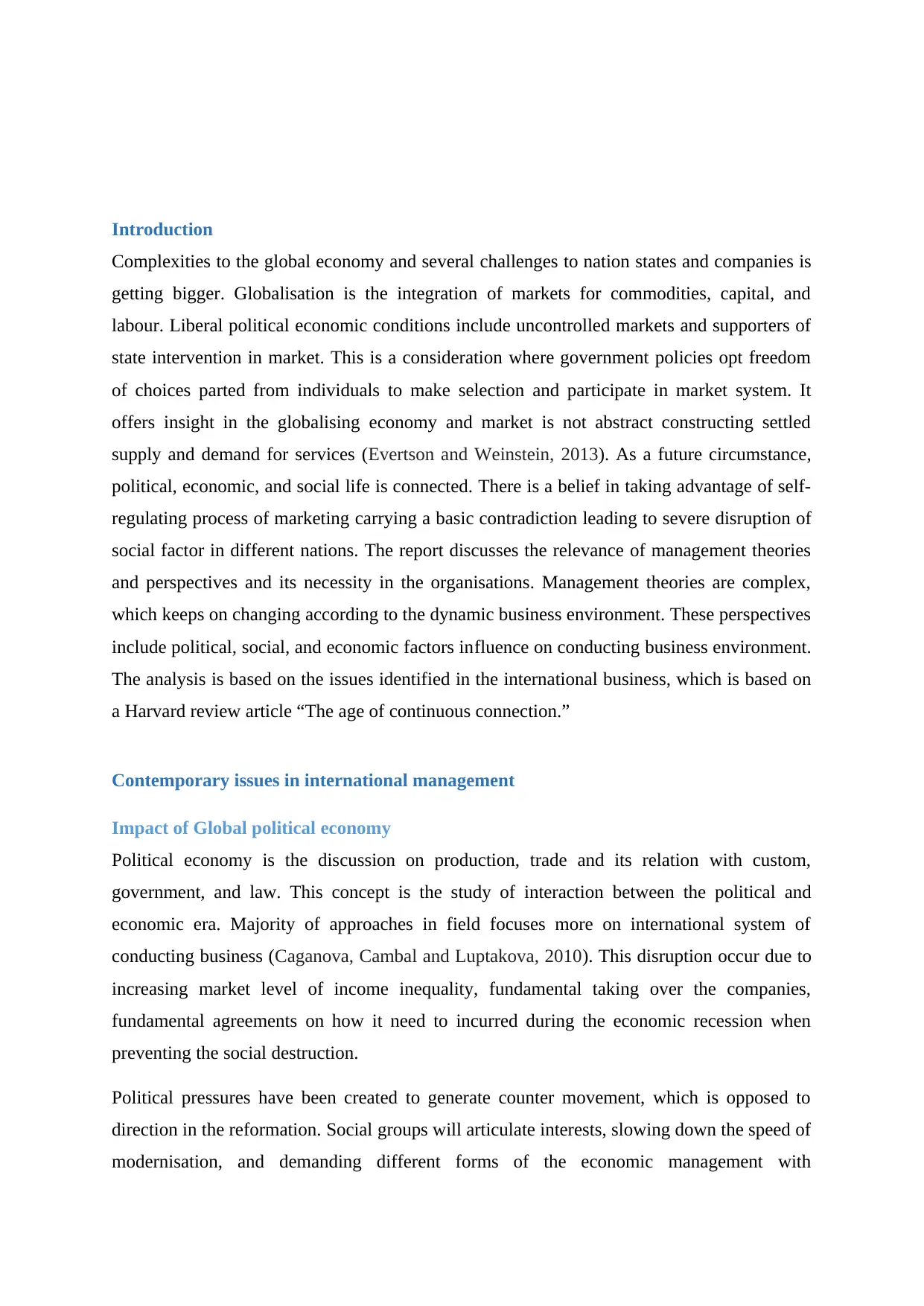
Introduction
Complexities to the global economy and several challenges to nation states and companies is
getting bigger. Globalisation is the integration of markets for commodities, capital, and
labour. Liberal political economic conditions include uncontrolled markets and supporters of
state intervention in market. This is a consideration where government policies opt freedom
of choices parted from individuals to make selection and participate in market system. It
offers insight in the globalising economy and market is not abstract constructing settled
supply and demand for services (Evertson and Weinstein, 2013). As a future circumstance,
political, economic, and social life is connected. There is a belief in taking advantage of self-
regulating process of marketing carrying a basic contradiction leading to severe disruption of
social factor in different nations. The report discusses the relevance of management theories
and perspectives and its necessity in the organisations. Management theories are complex,
which keeps on changing according to the dynamic business environment. These perspectives
include political, social, and economic factors influence on conducting business environment.
The analysis is based on the issues identified in the international business, which is based on
a Harvard review article “The age of continuous connection.”
Contemporary issues in international management
Impact of Global political economy
Political economy is the discussion on production, trade and its relation with custom,
government, and law. This concept is the study of interaction between the political and
economic era. Majority of approaches in field focuses more on international system of
conducting business (Caganova, Cambal and Luptakova, 2010). This disruption occur due to
increasing market level of income inequality, fundamental taking over the companies,
fundamental agreements on how it need to incurred during the economic recession when
preventing the social destruction.
Political pressures have been created to generate counter movement, which is opposed to
direction in the reformation. Social groups will articulate interests, slowing down the speed of
modernisation, and demanding different forms of the economic management with
Complexities to the global economy and several challenges to nation states and companies is
getting bigger. Globalisation is the integration of markets for commodities, capital, and
labour. Liberal political economic conditions include uncontrolled markets and supporters of
state intervention in market. This is a consideration where government policies opt freedom
of choices parted from individuals to make selection and participate in market system. It
offers insight in the globalising economy and market is not abstract constructing settled
supply and demand for services (Evertson and Weinstein, 2013). As a future circumstance,
political, economic, and social life is connected. There is a belief in taking advantage of self-
regulating process of marketing carrying a basic contradiction leading to severe disruption of
social factor in different nations. The report discusses the relevance of management theories
and perspectives and its necessity in the organisations. Management theories are complex,
which keeps on changing according to the dynamic business environment. These perspectives
include political, social, and economic factors influence on conducting business environment.
The analysis is based on the issues identified in the international business, which is based on
a Harvard review article “The age of continuous connection.”
Contemporary issues in international management
Impact of Global political economy
Political economy is the discussion on production, trade and its relation with custom,
government, and law. This concept is the study of interaction between the political and
economic era. Majority of approaches in field focuses more on international system of
conducting business (Caganova, Cambal and Luptakova, 2010). This disruption occur due to
increasing market level of income inequality, fundamental taking over the companies,
fundamental agreements on how it need to incurred during the economic recession when
preventing the social destruction.
Political pressures have been created to generate counter movement, which is opposed to
direction in the reformation. Social groups will articulate interests, slowing down the speed of
modernisation, and demanding different forms of the economic management with
⊘ This is a preview!⊘
Do you want full access?
Subscribe today to unlock all pages.

Trusted by 1+ million students worldwide
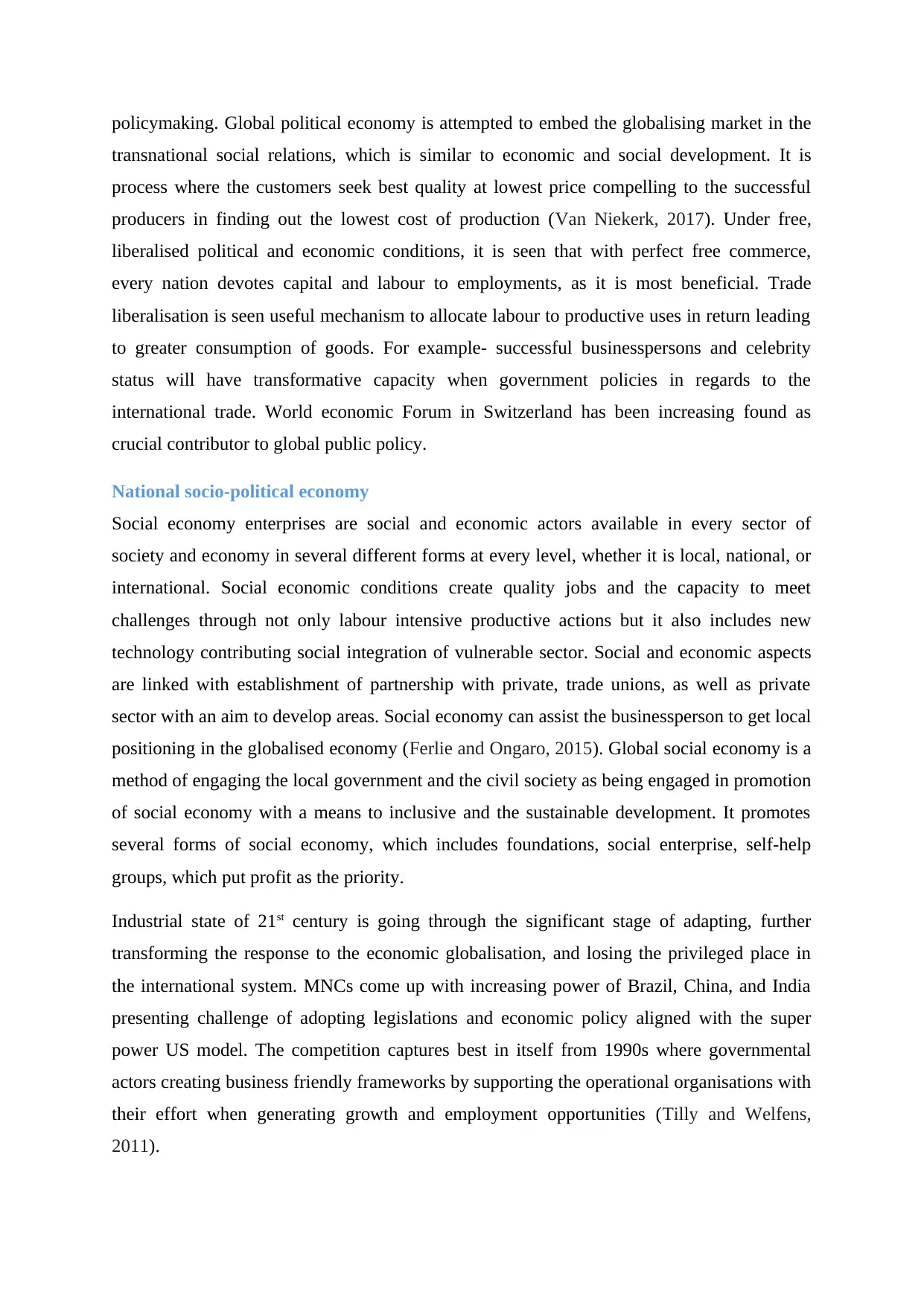
policymaking. Global political economy is attempted to embed the globalising market in the
transnational social relations, which is similar to economic and social development. It is
process where the customers seek best quality at lowest price compelling to the successful
producers in finding out the lowest cost of production (Van Niekerk, 2017). Under free,
liberalised political and economic conditions, it is seen that with perfect free commerce,
every nation devotes capital and labour to employments, as it is most beneficial. Trade
liberalisation is seen useful mechanism to allocate labour to productive uses in return leading
to greater consumption of goods. For example- successful businesspersons and celebrity
status will have transformative capacity when government policies in regards to the
international trade. World economic Forum in Switzerland has been increasing found as
crucial contributor to global public policy.
National socio-political economy
Social economy enterprises are social and economic actors available in every sector of
society and economy in several different forms at every level, whether it is local, national, or
international. Social economic conditions create quality jobs and the capacity to meet
challenges through not only labour intensive productive actions but it also includes new
technology contributing social integration of vulnerable sector. Social and economic aspects
are linked with establishment of partnership with private, trade unions, as well as private
sector with an aim to develop areas. Social economy can assist the businessperson to get local
positioning in the globalised economy (Ferlie and Ongaro, 2015). Global social economy is a
method of engaging the local government and the civil society as being engaged in promotion
of social economy with a means to inclusive and the sustainable development. It promotes
several forms of social economy, which includes foundations, social enterprise, self-help
groups, which put profit as the priority.
Industrial state of 21st century is going through the significant stage of adapting, further
transforming the response to the economic globalisation, and losing the privileged place in
the international system. MNCs come up with increasing power of Brazil, China, and India
presenting challenge of adopting legislations and economic policy aligned with the super
power US model. The competition captures best in itself from 1990s where governmental
actors creating business friendly frameworks by supporting the operational organisations with
their effort when generating growth and employment opportunities (Tilly and Welfens,
2011).
transnational social relations, which is similar to economic and social development. It is
process where the customers seek best quality at lowest price compelling to the successful
producers in finding out the lowest cost of production (Van Niekerk, 2017). Under free,
liberalised political and economic conditions, it is seen that with perfect free commerce,
every nation devotes capital and labour to employments, as it is most beneficial. Trade
liberalisation is seen useful mechanism to allocate labour to productive uses in return leading
to greater consumption of goods. For example- successful businesspersons and celebrity
status will have transformative capacity when government policies in regards to the
international trade. World economic Forum in Switzerland has been increasing found as
crucial contributor to global public policy.
National socio-political economy
Social economy enterprises are social and economic actors available in every sector of
society and economy in several different forms at every level, whether it is local, national, or
international. Social economic conditions create quality jobs and the capacity to meet
challenges through not only labour intensive productive actions but it also includes new
technology contributing social integration of vulnerable sector. Social and economic aspects
are linked with establishment of partnership with private, trade unions, as well as private
sector with an aim to develop areas. Social economy can assist the businessperson to get local
positioning in the globalised economy (Ferlie and Ongaro, 2015). Global social economy is a
method of engaging the local government and the civil society as being engaged in promotion
of social economy with a means to inclusive and the sustainable development. It promotes
several forms of social economy, which includes foundations, social enterprise, self-help
groups, which put profit as the priority.
Industrial state of 21st century is going through the significant stage of adapting, further
transforming the response to the economic globalisation, and losing the privileged place in
the international system. MNCs come up with increasing power of Brazil, China, and India
presenting challenge of adopting legislations and economic policy aligned with the super
power US model. The competition captures best in itself from 1990s where governmental
actors creating business friendly frameworks by supporting the operational organisations with
their effort when generating growth and employment opportunities (Tilly and Welfens,
2011).
Paraphrase This Document
Need a fresh take? Get an instant paraphrase of this document with our AI Paraphraser
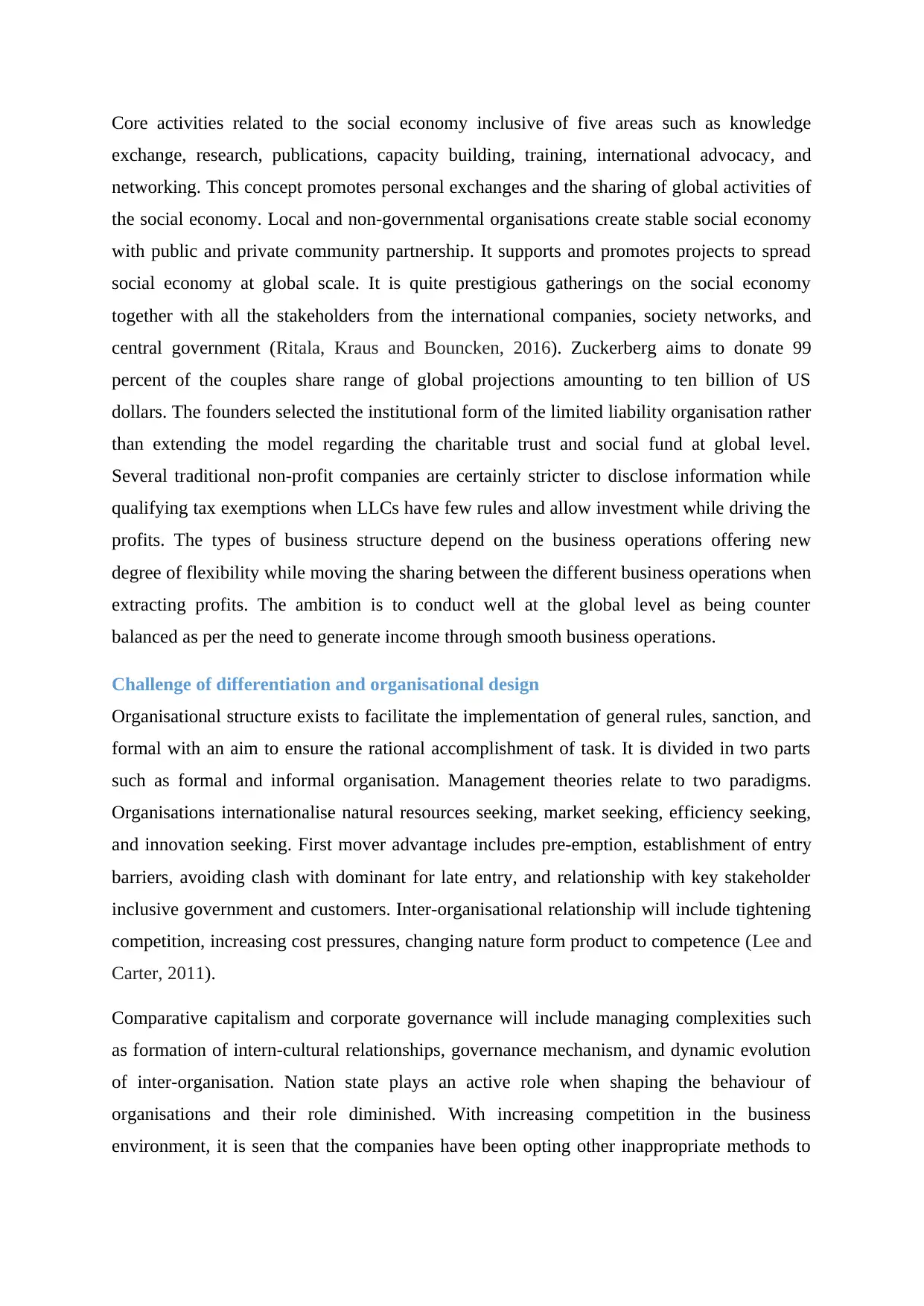
Core activities related to the social economy inclusive of five areas such as knowledge
exchange, research, publications, capacity building, training, international advocacy, and
networking. This concept promotes personal exchanges and the sharing of global activities of
the social economy. Local and non-governmental organisations create stable social economy
with public and private community partnership. It supports and promotes projects to spread
social economy at global scale. It is quite prestigious gatherings on the social economy
together with all the stakeholders from the international companies, society networks, and
central government (Ritala, Kraus and Bouncken, 2016). Zuckerberg aims to donate 99
percent of the couples share range of global projections amounting to ten billion of US
dollars. The founders selected the institutional form of the limited liability organisation rather
than extending the model regarding the charitable trust and social fund at global level.
Several traditional non-profit companies are certainly stricter to disclose information while
qualifying tax exemptions when LLCs have few rules and allow investment while driving the
profits. The types of business structure depend on the business operations offering new
degree of flexibility while moving the sharing between the different business operations when
extracting profits. The ambition is to conduct well at the global level as being counter
balanced as per the need to generate income through smooth business operations.
Challenge of differentiation and organisational design
Organisational structure exists to facilitate the implementation of general rules, sanction, and
formal with an aim to ensure the rational accomplishment of task. It is divided in two parts
such as formal and informal organisation. Management theories relate to two paradigms.
Organisations internationalise natural resources seeking, market seeking, efficiency seeking,
and innovation seeking. First mover advantage includes pre-emption, establishment of entry
barriers, avoiding clash with dominant for late entry, and relationship with key stakeholder
inclusive government and customers. Inter-organisational relationship will include tightening
competition, increasing cost pressures, changing nature form product to competence (Lee and
Carter, 2011).
Comparative capitalism and corporate governance will include managing complexities such
as formation of intern-cultural relationships, governance mechanism, and dynamic evolution
of inter-organisation. Nation state plays an active role when shaping the behaviour of
organisations and their role diminished. With increasing competition in the business
environment, it is seen that the companies have been opting other inappropriate methods to
exchange, research, publications, capacity building, training, international advocacy, and
networking. This concept promotes personal exchanges and the sharing of global activities of
the social economy. Local and non-governmental organisations create stable social economy
with public and private community partnership. It supports and promotes projects to spread
social economy at global scale. It is quite prestigious gatherings on the social economy
together with all the stakeholders from the international companies, society networks, and
central government (Ritala, Kraus and Bouncken, 2016). Zuckerberg aims to donate 99
percent of the couples share range of global projections amounting to ten billion of US
dollars. The founders selected the institutional form of the limited liability organisation rather
than extending the model regarding the charitable trust and social fund at global level.
Several traditional non-profit companies are certainly stricter to disclose information while
qualifying tax exemptions when LLCs have few rules and allow investment while driving the
profits. The types of business structure depend on the business operations offering new
degree of flexibility while moving the sharing between the different business operations when
extracting profits. The ambition is to conduct well at the global level as being counter
balanced as per the need to generate income through smooth business operations.
Challenge of differentiation and organisational design
Organisational structure exists to facilitate the implementation of general rules, sanction, and
formal with an aim to ensure the rational accomplishment of task. It is divided in two parts
such as formal and informal organisation. Management theories relate to two paradigms.
Organisations internationalise natural resources seeking, market seeking, efficiency seeking,
and innovation seeking. First mover advantage includes pre-emption, establishment of entry
barriers, avoiding clash with dominant for late entry, and relationship with key stakeholder
inclusive government and customers. Inter-organisational relationship will include tightening
competition, increasing cost pressures, changing nature form product to competence (Lee and
Carter, 2011).
Comparative capitalism and corporate governance will include managing complexities such
as formation of intern-cultural relationships, governance mechanism, and dynamic evolution
of inter-organisation. Nation state plays an active role when shaping the behaviour of
organisations and their role diminished. With increasing competition in the business
environment, it is seen that the companies have been opting other inappropriate methods to
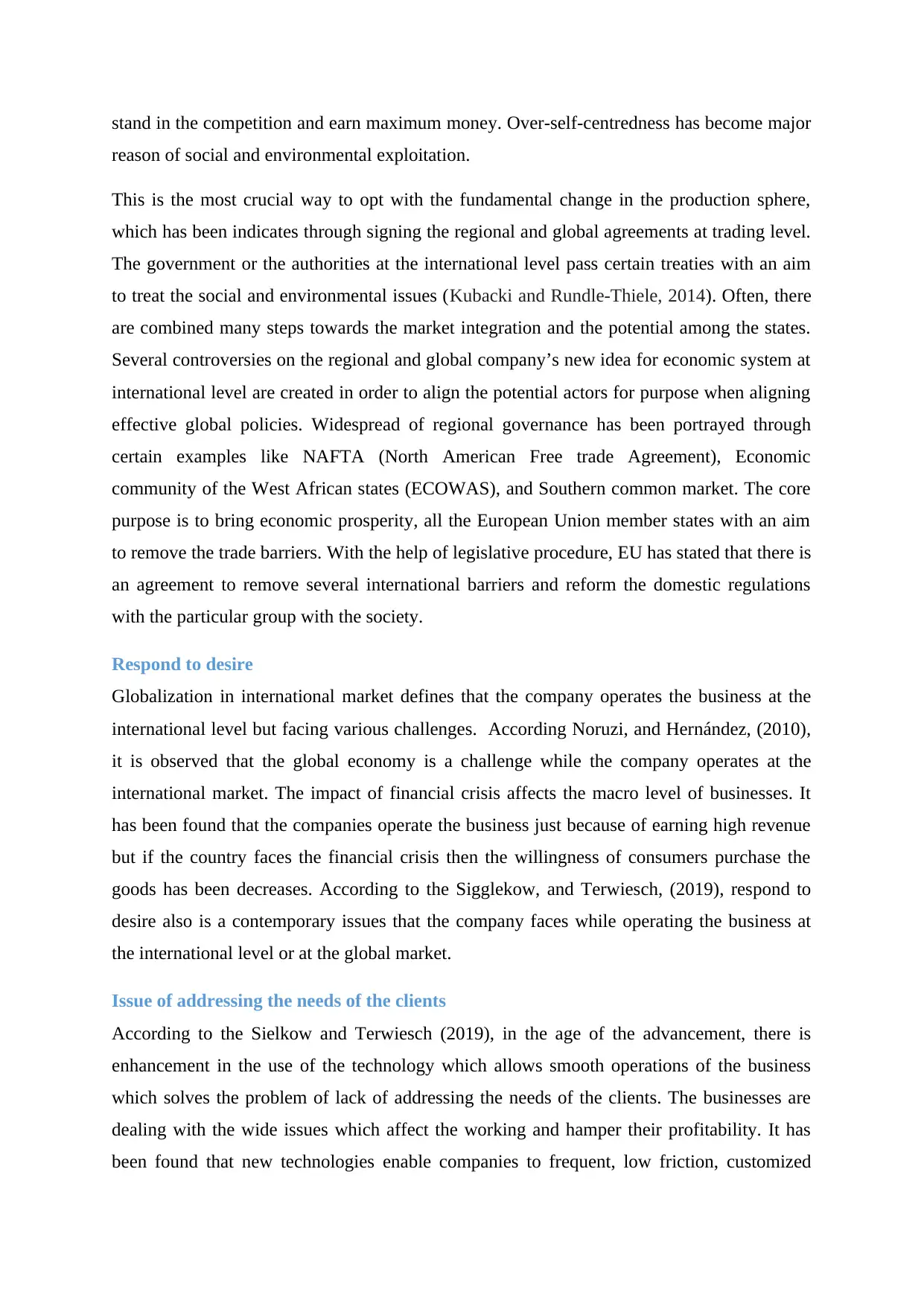
stand in the competition and earn maximum money. Over-self-centredness has become major
reason of social and environmental exploitation.
This is the most crucial way to opt with the fundamental change in the production sphere,
which has been indicates through signing the regional and global agreements at trading level.
The government or the authorities at the international level pass certain treaties with an aim
to treat the social and environmental issues (Kubacki and Rundle-Thiele, 2014). Often, there
are combined many steps towards the market integration and the potential among the states.
Several controversies on the regional and global company’s new idea for economic system at
international level are created in order to align the potential actors for purpose when aligning
effective global policies. Widespread of regional governance has been portrayed through
certain examples like NAFTA (North American Free trade Agreement), Economic
community of the West African states (ECOWAS), and Southern common market. The core
purpose is to bring economic prosperity, all the European Union member states with an aim
to remove the trade barriers. With the help of legislative procedure, EU has stated that there is
an agreement to remove several international barriers and reform the domestic regulations
with the particular group with the society.
Respond to desire
Globalization in international market defines that the company operates the business at the
international level but facing various challenges. According Noruzi, and Hernández, (2010),
it is observed that the global economy is a challenge while the company operates at the
international market. The impact of financial crisis affects the macro level of businesses. It
has been found that the companies operate the business just because of earning high revenue
but if the country faces the financial crisis then the willingness of consumers purchase the
goods has been decreases. According to the Sigglekow, and Terwiesch, (2019), respond to
desire also is a contemporary issues that the company faces while operating the business at
the international level or at the global market.
Issue of addressing the needs of the clients
According to the Sielkow and Terwiesch (2019), in the age of the advancement, there is
enhancement in the use of the technology which allows smooth operations of the business
which solves the problem of lack of addressing the needs of the clients. The businesses are
dealing with the wide issues which affect the working and hamper their profitability. It has
been found that new technologies enable companies to frequent, low friction, customized
reason of social and environmental exploitation.
This is the most crucial way to opt with the fundamental change in the production sphere,
which has been indicates through signing the regional and global agreements at trading level.
The government or the authorities at the international level pass certain treaties with an aim
to treat the social and environmental issues (Kubacki and Rundle-Thiele, 2014). Often, there
are combined many steps towards the market integration and the potential among the states.
Several controversies on the regional and global company’s new idea for economic system at
international level are created in order to align the potential actors for purpose when aligning
effective global policies. Widespread of regional governance has been portrayed through
certain examples like NAFTA (North American Free trade Agreement), Economic
community of the West African states (ECOWAS), and Southern common market. The core
purpose is to bring economic prosperity, all the European Union member states with an aim
to remove the trade barriers. With the help of legislative procedure, EU has stated that there is
an agreement to remove several international barriers and reform the domestic regulations
with the particular group with the society.
Respond to desire
Globalization in international market defines that the company operates the business at the
international level but facing various challenges. According Noruzi, and Hernández, (2010),
it is observed that the global economy is a challenge while the company operates at the
international market. The impact of financial crisis affects the macro level of businesses. It
has been found that the companies operate the business just because of earning high revenue
but if the country faces the financial crisis then the willingness of consumers purchase the
goods has been decreases. According to the Sigglekow, and Terwiesch, (2019), respond to
desire also is a contemporary issues that the company faces while operating the business at
the international level or at the global market.
Issue of addressing the needs of the clients
According to the Sielkow and Terwiesch (2019), in the age of the advancement, there is
enhancement in the use of the technology which allows smooth operations of the business
which solves the problem of lack of addressing the needs of the clients. The businesses are
dealing with the wide issues which affect the working and hamper their profitability. It has
been found that new technologies enable companies to frequent, low friction, customized
⊘ This is a preview!⊘
Do you want full access?
Subscribe today to unlock all pages.

Trusted by 1+ million students worldwide
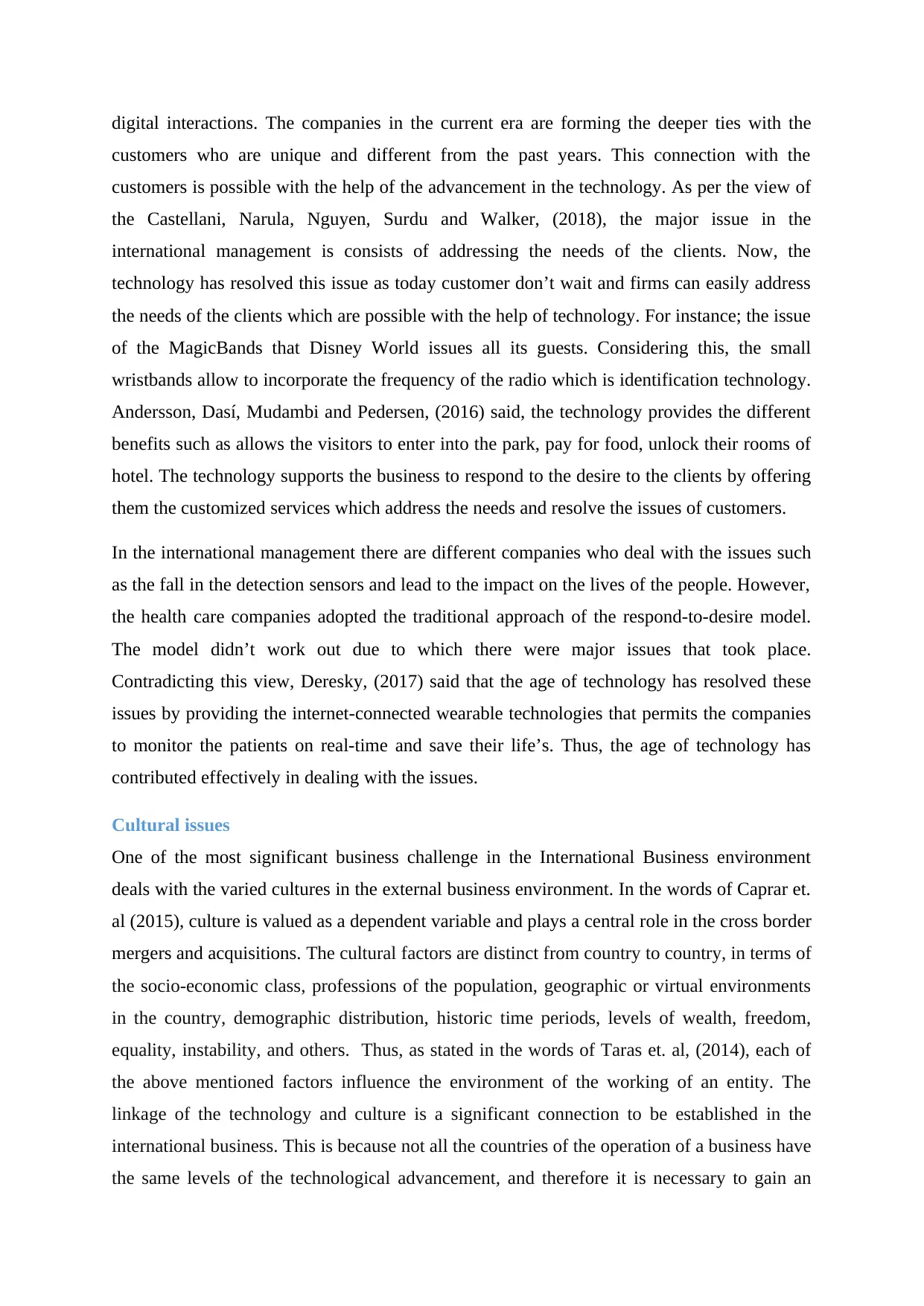
digital interactions. The companies in the current era are forming the deeper ties with the
customers who are unique and different from the past years. This connection with the
customers is possible with the help of the advancement in the technology. As per the view of
the Castellani, Narula, Nguyen, Surdu and Walker, (2018), the major issue in the
international management is consists of addressing the needs of the clients. Now, the
technology has resolved this issue as today customer don’t wait and firms can easily address
the needs of the clients which are possible with the help of technology. For instance; the issue
of the MagicBands that Disney World issues all its guests. Considering this, the small
wristbands allow to incorporate the frequency of the radio which is identification technology.
Andersson, Dasí, Mudambi and Pedersen, (2016) said, the technology provides the different
benefits such as allows the visitors to enter into the park, pay for food, unlock their rooms of
hotel. The technology supports the business to respond to the desire to the clients by offering
them the customized services which address the needs and resolve the issues of customers.
In the international management there are different companies who deal with the issues such
as the fall in the detection sensors and lead to the impact on the lives of the people. However,
the health care companies adopted the traditional approach of the respond-to-desire model.
The model didn’t work out due to which there were major issues that took place.
Contradicting this view, Deresky, (2017) said that the age of technology has resolved these
issues by providing the internet-connected wearable technologies that permits the companies
to monitor the patients on real-time and save their life’s. Thus, the age of technology has
contributed effectively in dealing with the issues.
Cultural issues
One of the most significant business challenge in the International Business environment
deals with the varied cultures in the external business environment. In the words of Caprar et.
al (2015), culture is valued as a dependent variable and plays a central role in the cross border
mergers and acquisitions. The cultural factors are distinct from country to country, in terms of
the socio-economic class, professions of the population, geographic or virtual environments
in the country, demographic distribution, historic time periods, levels of wealth, freedom,
equality, instability, and others. Thus, as stated in the words of Taras et. al, (2014), each of
the above mentioned factors influence the environment of the working of an entity. The
linkage of the technology and culture is a significant connection to be established in the
international business. This is because not all the countries of the operation of a business have
the same levels of the technological advancement, and therefore it is necessary to gain an
customers who are unique and different from the past years. This connection with the
customers is possible with the help of the advancement in the technology. As per the view of
the Castellani, Narula, Nguyen, Surdu and Walker, (2018), the major issue in the
international management is consists of addressing the needs of the clients. Now, the
technology has resolved this issue as today customer don’t wait and firms can easily address
the needs of the clients which are possible with the help of technology. For instance; the issue
of the MagicBands that Disney World issues all its guests. Considering this, the small
wristbands allow to incorporate the frequency of the radio which is identification technology.
Andersson, Dasí, Mudambi and Pedersen, (2016) said, the technology provides the different
benefits such as allows the visitors to enter into the park, pay for food, unlock their rooms of
hotel. The technology supports the business to respond to the desire to the clients by offering
them the customized services which address the needs and resolve the issues of customers.
In the international management there are different companies who deal with the issues such
as the fall in the detection sensors and lead to the impact on the lives of the people. However,
the health care companies adopted the traditional approach of the respond-to-desire model.
The model didn’t work out due to which there were major issues that took place.
Contradicting this view, Deresky, (2017) said that the age of technology has resolved these
issues by providing the internet-connected wearable technologies that permits the companies
to monitor the patients on real-time and save their life’s. Thus, the age of technology has
contributed effectively in dealing with the issues.
Cultural issues
One of the most significant business challenge in the International Business environment
deals with the varied cultures in the external business environment. In the words of Caprar et.
al (2015), culture is valued as a dependent variable and plays a central role in the cross border
mergers and acquisitions. The cultural factors are distinct from country to country, in terms of
the socio-economic class, professions of the population, geographic or virtual environments
in the country, demographic distribution, historic time periods, levels of wealth, freedom,
equality, instability, and others. Thus, as stated in the words of Taras et. al, (2014), each of
the above mentioned factors influence the environment of the working of an entity. The
linkage of the technology and culture is a significant connection to be established in the
international business. This is because not all the countries of the operation of a business have
the same levels of the technological advancement, and therefore it is necessary to gain an
Paraphrase This Document
Need a fresh take? Get an instant paraphrase of this document with our AI Paraphraser
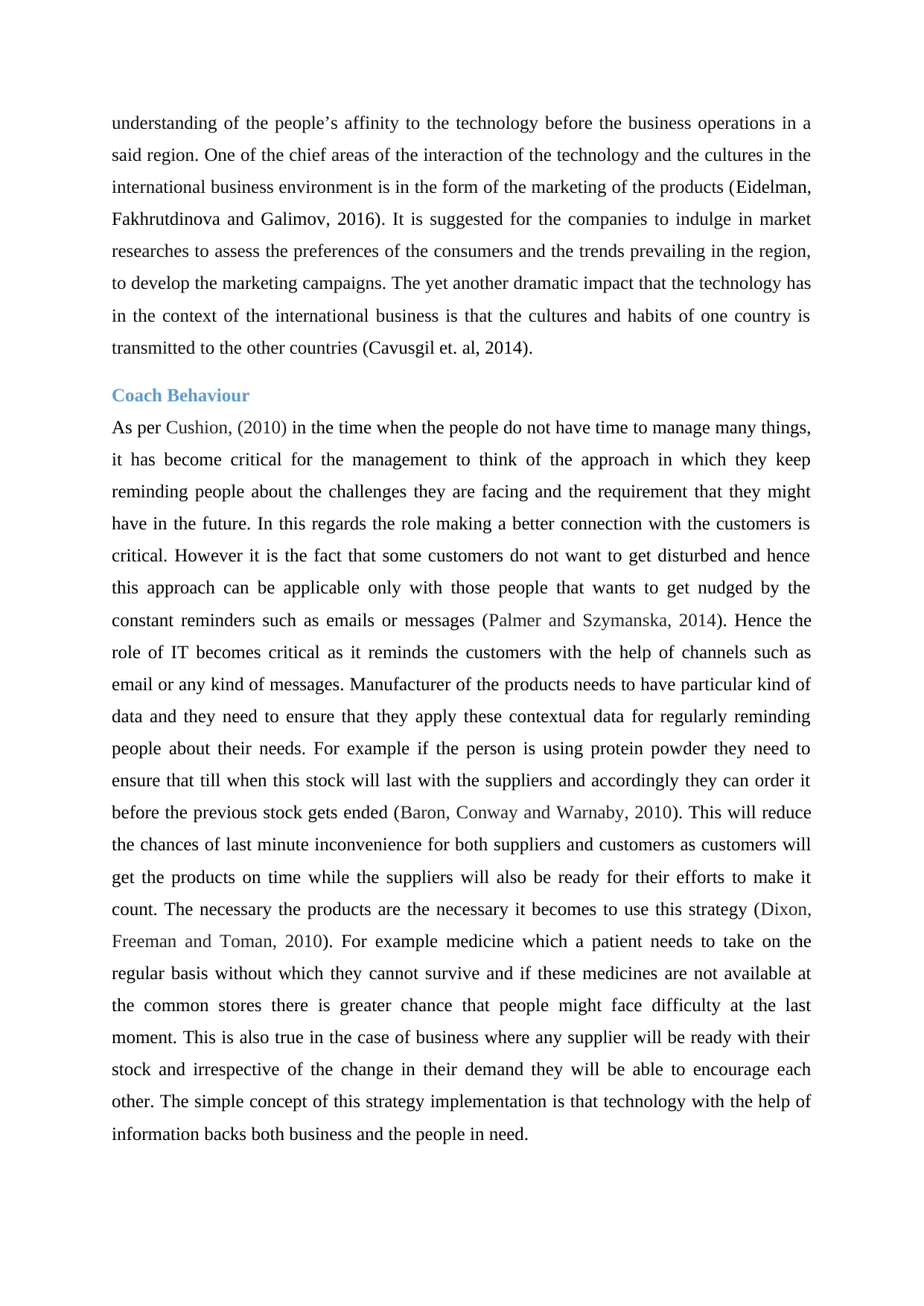
understanding of the people’s affinity to the technology before the business operations in a
said region. One of the chief areas of the interaction of the technology and the cultures in the
international business environment is in the form of the marketing of the products (Eidelman,
Fakhrutdinova and Galimov, 2016). It is suggested for the companies to indulge in market
researches to assess the preferences of the consumers and the trends prevailing in the region,
to develop the marketing campaigns. The yet another dramatic impact that the technology has
in the context of the international business is that the cultures and habits of one country is
transmitted to the other countries (Cavusgil et. al, 2014).
Coach Behaviour
As per Cushion, (2010) in the time when the people do not have time to manage many things,
it has become critical for the management to think of the approach in which they keep
reminding people about the challenges they are facing and the requirement that they might
have in the future. In this regards the role making a better connection with the customers is
critical. However it is the fact that some customers do not want to get disturbed and hence
this approach can be applicable only with those people that wants to get nudged by the
constant reminders such as emails or messages (Palmer and Szymanska, 2014). Hence the
role of IT becomes critical as it reminds the customers with the help of channels such as
email or any kind of messages. Manufacturer of the products needs to have particular kind of
data and they need to ensure that they apply these contextual data for regularly reminding
people about their needs. For example if the person is using protein powder they need to
ensure that till when this stock will last with the suppliers and accordingly they can order it
before the previous stock gets ended (Baron, Conway and Warnaby, 2010). This will reduce
the chances of last minute inconvenience for both suppliers and customers as customers will
get the products on time while the suppliers will also be ready for their efforts to make it
count. The necessary the products are the necessary it becomes to use this strategy (Dixon,
Freeman and Toman, 2010). For example medicine which a patient needs to take on the
regular basis without which they cannot survive and if these medicines are not available at
the common stores there is greater chance that people might face difficulty at the last
moment. This is also true in the case of business where any supplier will be ready with their
stock and irrespective of the change in their demand they will be able to encourage each
other. The simple concept of this strategy implementation is that technology with the help of
information backs both business and the people in need.
said region. One of the chief areas of the interaction of the technology and the cultures in the
international business environment is in the form of the marketing of the products (Eidelman,
Fakhrutdinova and Galimov, 2016). It is suggested for the companies to indulge in market
researches to assess the preferences of the consumers and the trends prevailing in the region,
to develop the marketing campaigns. The yet another dramatic impact that the technology has
in the context of the international business is that the cultures and habits of one country is
transmitted to the other countries (Cavusgil et. al, 2014).
Coach Behaviour
As per Cushion, (2010) in the time when the people do not have time to manage many things,
it has become critical for the management to think of the approach in which they keep
reminding people about the challenges they are facing and the requirement that they might
have in the future. In this regards the role making a better connection with the customers is
critical. However it is the fact that some customers do not want to get disturbed and hence
this approach can be applicable only with those people that wants to get nudged by the
constant reminders such as emails or messages (Palmer and Szymanska, 2014). Hence the
role of IT becomes critical as it reminds the customers with the help of channels such as
email or any kind of messages. Manufacturer of the products needs to have particular kind of
data and they need to ensure that they apply these contextual data for regularly reminding
people about their needs. For example if the person is using protein powder they need to
ensure that till when this stock will last with the suppliers and accordingly they can order it
before the previous stock gets ended (Baron, Conway and Warnaby, 2010). This will reduce
the chances of last minute inconvenience for both suppliers and customers as customers will
get the products on time while the suppliers will also be ready for their efforts to make it
count. The necessary the products are the necessary it becomes to use this strategy (Dixon,
Freeman and Toman, 2010). For example medicine which a patient needs to take on the
regular basis without which they cannot survive and if these medicines are not available at
the common stores there is greater chance that people might face difficulty at the last
moment. This is also true in the case of business where any supplier will be ready with their
stock and irrespective of the change in their demand they will be able to encourage each
other. The simple concept of this strategy implementation is that technology with the help of
information backs both business and the people in need.
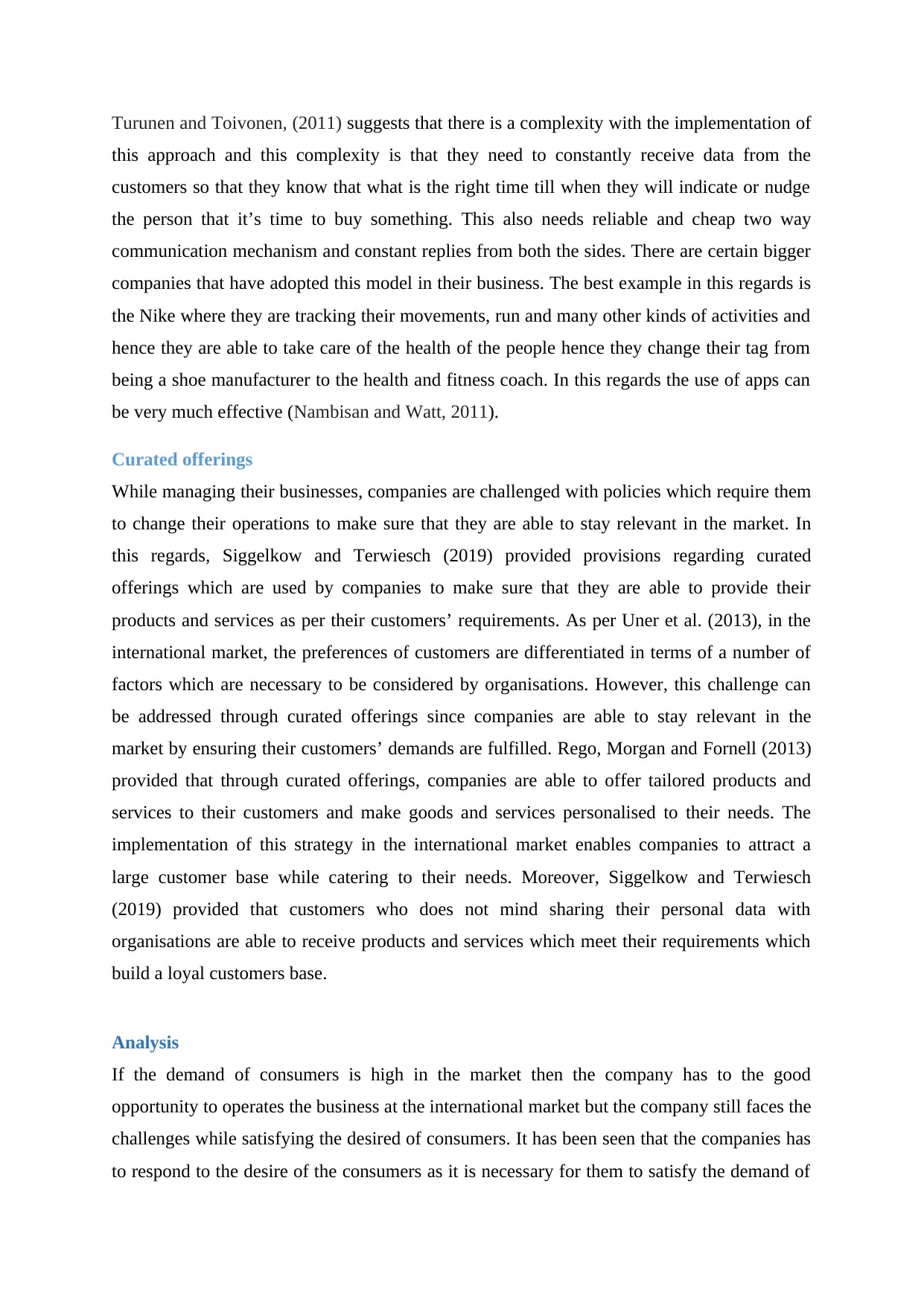
Turunen and Toivonen, (2011) suggests that there is a complexity with the implementation of
this approach and this complexity is that they need to constantly receive data from the
customers so that they know that what is the right time till when they will indicate or nudge
the person that it’s time to buy something. This also needs reliable and cheap two way
communication mechanism and constant replies from both the sides. There are certain bigger
companies that have adopted this model in their business. The best example in this regards is
the Nike where they are tracking their movements, run and many other kinds of activities and
hence they are able to take care of the health of the people hence they change their tag from
being a shoe manufacturer to the health and fitness coach. In this regards the use of apps can
be very much effective (Nambisan and Watt, 2011).
Curated offerings
While managing their businesses, companies are challenged with policies which require them
to change their operations to make sure that they are able to stay relevant in the market. In
this regards, Siggelkow and Terwiesch (2019) provided provisions regarding curated
offerings which are used by companies to make sure that they are able to provide their
products and services as per their customers’ requirements. As per Uner et al. (2013), in the
international market, the preferences of customers are differentiated in terms of a number of
factors which are necessary to be considered by organisations. However, this challenge can
be addressed through curated offerings since companies are able to stay relevant in the
market by ensuring their customers’ demands are fulfilled. Rego, Morgan and Fornell (2013)
provided that through curated offerings, companies are able to offer tailored products and
services to their customers and make goods and services personalised to their needs. The
implementation of this strategy in the international market enables companies to attract a
large customer base while catering to their needs. Moreover, Siggelkow and Terwiesch
(2019) provided that customers who does not mind sharing their personal data with
organisations are able to receive products and services which meet their requirements which
build a loyal customers base.
Analysis
If the demand of consumers is high in the market then the company has to the good
opportunity to operates the business at the international market but the company still faces the
challenges while satisfying the desired of consumers. It has been seen that the companies has
to respond to the desire of the consumers as it is necessary for them to satisfy the demand of
this approach and this complexity is that they need to constantly receive data from the
customers so that they know that what is the right time till when they will indicate or nudge
the person that it’s time to buy something. This also needs reliable and cheap two way
communication mechanism and constant replies from both the sides. There are certain bigger
companies that have adopted this model in their business. The best example in this regards is
the Nike where they are tracking their movements, run and many other kinds of activities and
hence they are able to take care of the health of the people hence they change their tag from
being a shoe manufacturer to the health and fitness coach. In this regards the use of apps can
be very much effective (Nambisan and Watt, 2011).
Curated offerings
While managing their businesses, companies are challenged with policies which require them
to change their operations to make sure that they are able to stay relevant in the market. In
this regards, Siggelkow and Terwiesch (2019) provided provisions regarding curated
offerings which are used by companies to make sure that they are able to provide their
products and services as per their customers’ requirements. As per Uner et al. (2013), in the
international market, the preferences of customers are differentiated in terms of a number of
factors which are necessary to be considered by organisations. However, this challenge can
be addressed through curated offerings since companies are able to stay relevant in the
market by ensuring their customers’ demands are fulfilled. Rego, Morgan and Fornell (2013)
provided that through curated offerings, companies are able to offer tailored products and
services to their customers and make goods and services personalised to their needs. The
implementation of this strategy in the international market enables companies to attract a
large customer base while catering to their needs. Moreover, Siggelkow and Terwiesch
(2019) provided that customers who does not mind sharing their personal data with
organisations are able to receive products and services which meet their requirements which
build a loyal customers base.
Analysis
If the demand of consumers is high in the market then the company has to the good
opportunity to operates the business at the international market but the company still faces the
challenges while satisfying the desired of consumers. It has been seen that the companies has
to respond to the desire of the consumers as it is necessary for them to satisfy the demand of
⊘ This is a preview!⊘
Do you want full access?
Subscribe today to unlock all pages.

Trusted by 1+ million students worldwide
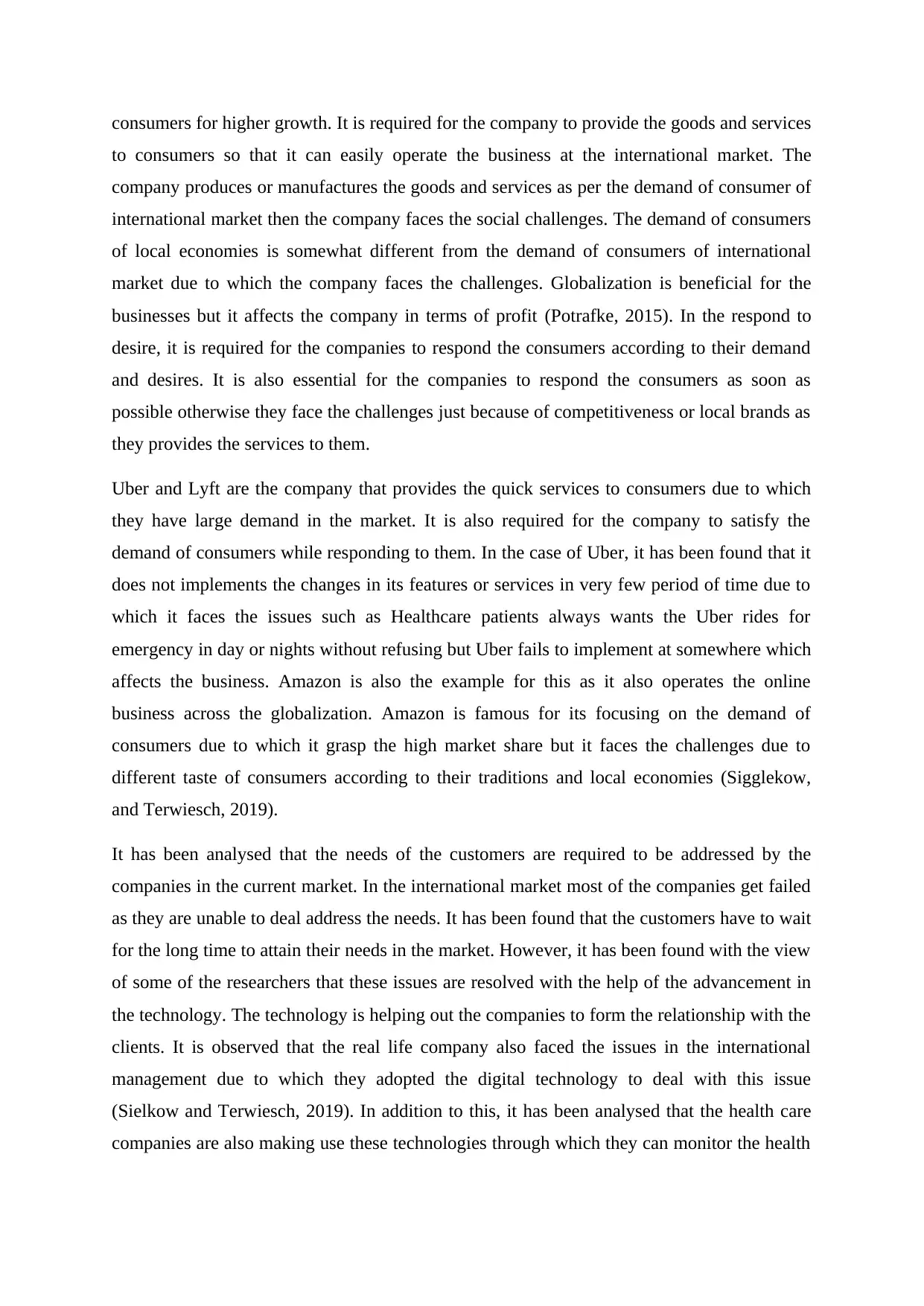
consumers for higher growth. It is required for the company to provide the goods and services
to consumers so that it can easily operate the business at the international market. The
company produces or manufactures the goods and services as per the demand of consumer of
international market then the company faces the social challenges. The demand of consumers
of local economies is somewhat different from the demand of consumers of international
market due to which the company faces the challenges. Globalization is beneficial for the
businesses but it affects the company in terms of profit (Potrafke, 2015). In the respond to
desire, it is required for the companies to respond the consumers according to their demand
and desires. It is also essential for the companies to respond the consumers as soon as
possible otherwise they face the challenges just because of competitiveness or local brands as
they provides the services to them.
Uber and Lyft are the company that provides the quick services to consumers due to which
they have large demand in the market. It is also required for the company to satisfy the
demand of consumers while responding to them. In the case of Uber, it has been found that it
does not implements the changes in its features or services in very few period of time due to
which it faces the issues such as Healthcare patients always wants the Uber rides for
emergency in day or nights without refusing but Uber fails to implement at somewhere which
affects the business. Amazon is also the example for this as it also operates the online
business across the globalization. Amazon is famous for its focusing on the demand of
consumers due to which it grasp the high market share but it faces the challenges due to
different taste of consumers according to their traditions and local economies (Sigglekow,
and Terwiesch, 2019).
It has been analysed that the needs of the customers are required to be addressed by the
companies in the current market. In the international market most of the companies get failed
as they are unable to deal address the needs. It has been found that the customers have to wait
for the long time to attain their needs in the market. However, it has been found with the view
of some of the researchers that these issues are resolved with the help of the advancement in
the technology. The technology is helping out the companies to form the relationship with the
clients. It is observed that the real life company also faced the issues in the international
management due to which they adopted the digital technology to deal with this issue
(Sielkow and Terwiesch, 2019). In addition to this, it has been analysed that the health care
companies are also making use these technologies through which they can monitor the health
to consumers so that it can easily operate the business at the international market. The
company produces or manufactures the goods and services as per the demand of consumer of
international market then the company faces the social challenges. The demand of consumers
of local economies is somewhat different from the demand of consumers of international
market due to which the company faces the challenges. Globalization is beneficial for the
businesses but it affects the company in terms of profit (Potrafke, 2015). In the respond to
desire, it is required for the companies to respond the consumers according to their demand
and desires. It is also essential for the companies to respond the consumers as soon as
possible otherwise they face the challenges just because of competitiveness or local brands as
they provides the services to them.
Uber and Lyft are the company that provides the quick services to consumers due to which
they have large demand in the market. It is also required for the company to satisfy the
demand of consumers while responding to them. In the case of Uber, it has been found that it
does not implements the changes in its features or services in very few period of time due to
which it faces the issues such as Healthcare patients always wants the Uber rides for
emergency in day or nights without refusing but Uber fails to implement at somewhere which
affects the business. Amazon is also the example for this as it also operates the online
business across the globalization. Amazon is famous for its focusing on the demand of
consumers due to which it grasp the high market share but it faces the challenges due to
different taste of consumers according to their traditions and local economies (Sigglekow,
and Terwiesch, 2019).
It has been analysed that the needs of the customers are required to be addressed by the
companies in the current market. In the international market most of the companies get failed
as they are unable to deal address the needs. It has been found that the customers have to wait
for the long time to attain their needs in the market. However, it has been found with the view
of some of the researchers that these issues are resolved with the help of the advancement in
the technology. The technology is helping out the companies to form the relationship with the
clients. It is observed that the real life company also faced the issues in the international
management due to which they adopted the digital technology to deal with this issue
(Sielkow and Terwiesch, 2019). In addition to this, it has been analysed that the health care
companies are also making use these technologies through which they can monitor the health
Paraphrase This Document
Need a fresh take? Get an instant paraphrase of this document with our AI Paraphraser
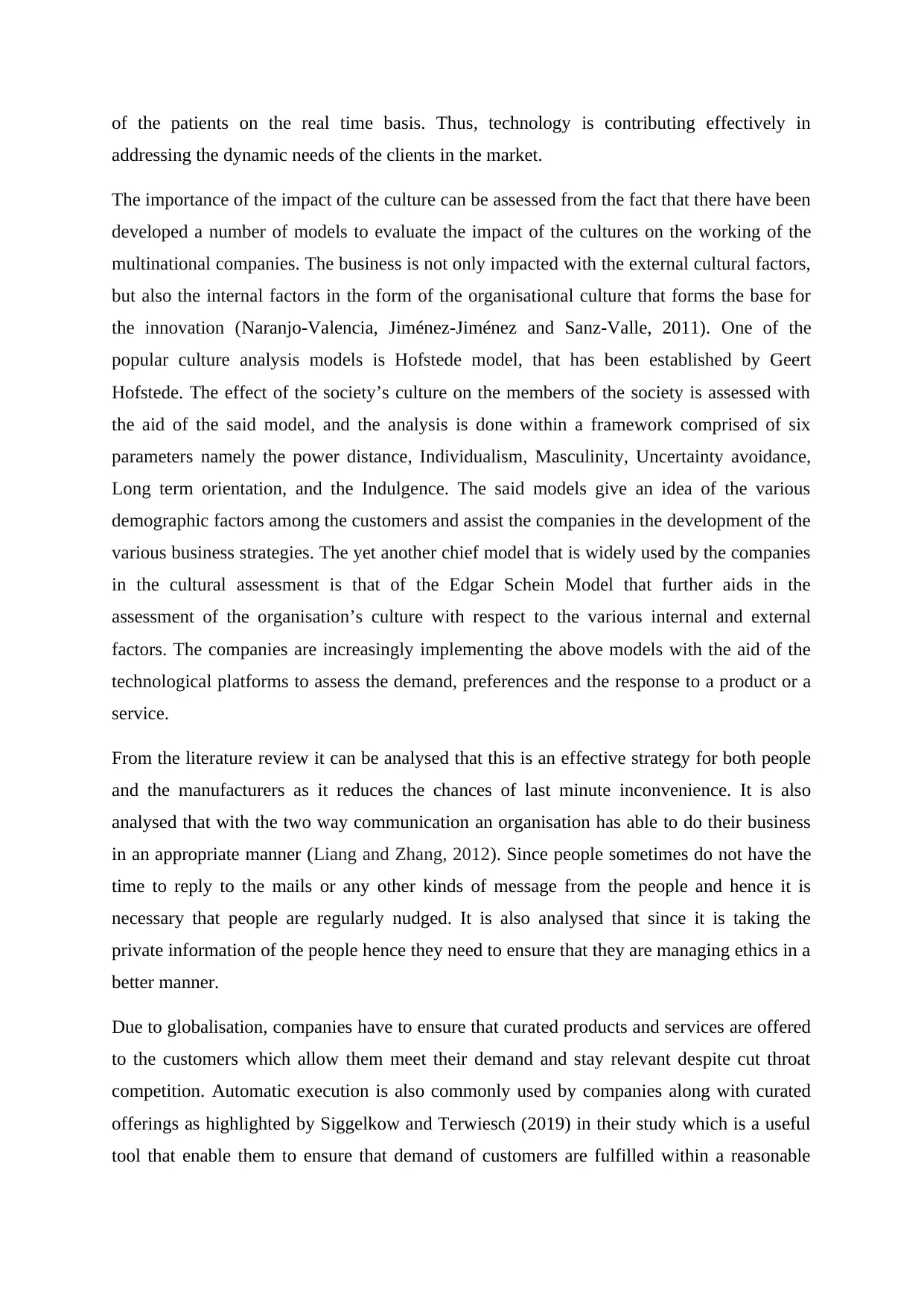
of the patients on the real time basis. Thus, technology is contributing effectively in
addressing the dynamic needs of the clients in the market.
The importance of the impact of the culture can be assessed from the fact that there have been
developed a number of models to evaluate the impact of the cultures on the working of the
multinational companies. The business is not only impacted with the external cultural factors,
but also the internal factors in the form of the organisational culture that forms the base for
the innovation (Naranjo-Valencia, Jiménez-Jiménez and Sanz-Valle, 2011). One of the
popular culture analysis models is Hofstede model, that has been established by Geert
Hofstede. The effect of the society’s culture on the members of the society is assessed with
the aid of the said model, and the analysis is done within a framework comprised of six
parameters namely the power distance, Individualism, Masculinity, Uncertainty avoidance,
Long term orientation, and the Indulgence. The said models give an idea of the various
demographic factors among the customers and assist the companies in the development of the
various business strategies. The yet another chief model that is widely used by the companies
in the cultural assessment is that of the Edgar Schein Model that further aids in the
assessment of the organisation’s culture with respect to the various internal and external
factors. The companies are increasingly implementing the above models with the aid of the
technological platforms to assess the demand, preferences and the response to a product or a
service.
From the literature review it can be analysed that this is an effective strategy for both people
and the manufacturers as it reduces the chances of last minute inconvenience. It is also
analysed that with the two way communication an organisation has able to do their business
in an appropriate manner (Liang and Zhang, 2012). Since people sometimes do not have the
time to reply to the mails or any other kinds of message from the people and hence it is
necessary that people are regularly nudged. It is also analysed that since it is taking the
private information of the people hence they need to ensure that they are managing ethics in a
better manner.
Due to globalisation, companies have to ensure that curated products and services are offered
to the customers which allow them meet their demand and stay relevant despite cut throat
competition. Automatic execution is also commonly used by companies along with curated
offerings as highlighted by Siggelkow and Terwiesch (2019) in their study which is a useful
tool that enable them to ensure that demand of customers are fulfilled within a reasonable
addressing the dynamic needs of the clients in the market.
The importance of the impact of the culture can be assessed from the fact that there have been
developed a number of models to evaluate the impact of the cultures on the working of the
multinational companies. The business is not only impacted with the external cultural factors,
but also the internal factors in the form of the organisational culture that forms the base for
the innovation (Naranjo-Valencia, Jiménez-Jiménez and Sanz-Valle, 2011). One of the
popular culture analysis models is Hofstede model, that has been established by Geert
Hofstede. The effect of the society’s culture on the members of the society is assessed with
the aid of the said model, and the analysis is done within a framework comprised of six
parameters namely the power distance, Individualism, Masculinity, Uncertainty avoidance,
Long term orientation, and the Indulgence. The said models give an idea of the various
demographic factors among the customers and assist the companies in the development of the
various business strategies. The yet another chief model that is widely used by the companies
in the cultural assessment is that of the Edgar Schein Model that further aids in the
assessment of the organisation’s culture with respect to the various internal and external
factors. The companies are increasingly implementing the above models with the aid of the
technological platforms to assess the demand, preferences and the response to a product or a
service.
From the literature review it can be analysed that this is an effective strategy for both people
and the manufacturers as it reduces the chances of last minute inconvenience. It is also
analysed that with the two way communication an organisation has able to do their business
in an appropriate manner (Liang and Zhang, 2012). Since people sometimes do not have the
time to reply to the mails or any other kinds of message from the people and hence it is
necessary that people are regularly nudged. It is also analysed that since it is taking the
private information of the people hence they need to ensure that they are managing ethics in a
better manner.
Due to globalisation, companies have to ensure that curated products and services are offered
to the customers which allow them meet their demand and stay relevant despite cut throat
competition. Automatic execution is also commonly used by companies along with curated
offerings as highlighted by Siggelkow and Terwiesch (2019) in their study which is a useful
tool that enable them to ensure that demand of customers are fulfilled within a reasonable
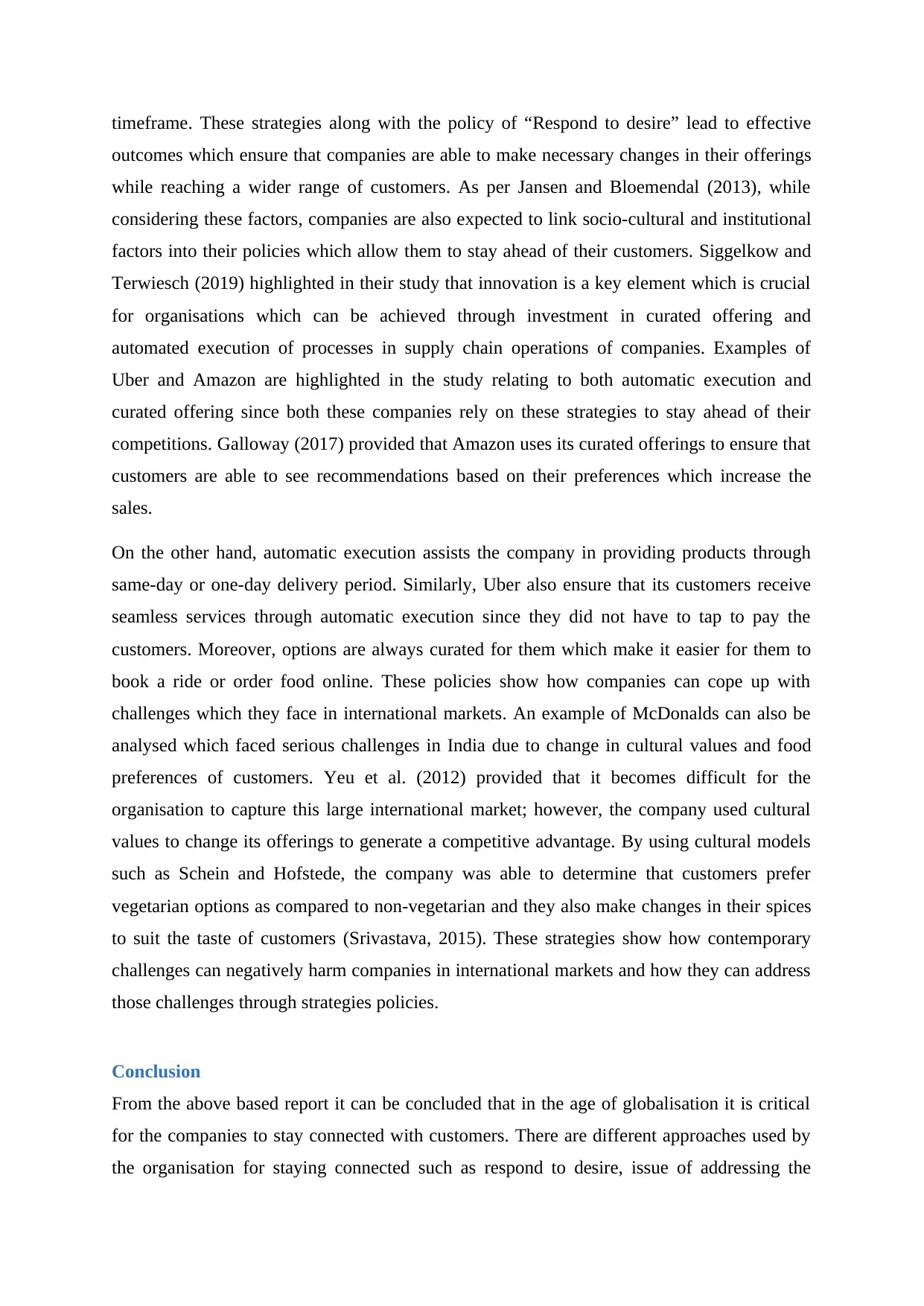
timeframe. These strategies along with the policy of “Respond to desire” lead to effective
outcomes which ensure that companies are able to make necessary changes in their offerings
while reaching a wider range of customers. As per Jansen and Bloemendal (2013), while
considering these factors, companies are also expected to link socio-cultural and institutional
factors into their policies which allow them to stay ahead of their customers. Siggelkow and
Terwiesch (2019) highlighted in their study that innovation is a key element which is crucial
for organisations which can be achieved through investment in curated offering and
automated execution of processes in supply chain operations of companies. Examples of
Uber and Amazon are highlighted in the study relating to both automatic execution and
curated offering since both these companies rely on these strategies to stay ahead of their
competitions. Galloway (2017) provided that Amazon uses its curated offerings to ensure that
customers are able to see recommendations based on their preferences which increase the
sales.
On the other hand, automatic execution assists the company in providing products through
same-day or one-day delivery period. Similarly, Uber also ensure that its customers receive
seamless services through automatic execution since they did not have to tap to pay the
customers. Moreover, options are always curated for them which make it easier for them to
book a ride or order food online. These policies show how companies can cope up with
challenges which they face in international markets. An example of McDonalds can also be
analysed which faced serious challenges in India due to change in cultural values and food
preferences of customers. Yeu et al. (2012) provided that it becomes difficult for the
organisation to capture this large international market; however, the company used cultural
values to change its offerings to generate a competitive advantage. By using cultural models
such as Schein and Hofstede, the company was able to determine that customers prefer
vegetarian options as compared to non-vegetarian and they also make changes in their spices
to suit the taste of customers (Srivastava, 2015). These strategies show how contemporary
challenges can negatively harm companies in international markets and how they can address
those challenges through strategies policies.
Conclusion
From the above based report it can be concluded that in the age of globalisation it is critical
for the companies to stay connected with customers. There are different approaches used by
the organisation for staying connected such as respond to desire, issue of addressing the
outcomes which ensure that companies are able to make necessary changes in their offerings
while reaching a wider range of customers. As per Jansen and Bloemendal (2013), while
considering these factors, companies are also expected to link socio-cultural and institutional
factors into their policies which allow them to stay ahead of their customers. Siggelkow and
Terwiesch (2019) highlighted in their study that innovation is a key element which is crucial
for organisations which can be achieved through investment in curated offering and
automated execution of processes in supply chain operations of companies. Examples of
Uber and Amazon are highlighted in the study relating to both automatic execution and
curated offering since both these companies rely on these strategies to stay ahead of their
competitions. Galloway (2017) provided that Amazon uses its curated offerings to ensure that
customers are able to see recommendations based on their preferences which increase the
sales.
On the other hand, automatic execution assists the company in providing products through
same-day or one-day delivery period. Similarly, Uber also ensure that its customers receive
seamless services through automatic execution since they did not have to tap to pay the
customers. Moreover, options are always curated for them which make it easier for them to
book a ride or order food online. These policies show how companies can cope up with
challenges which they face in international markets. An example of McDonalds can also be
analysed which faced serious challenges in India due to change in cultural values and food
preferences of customers. Yeu et al. (2012) provided that it becomes difficult for the
organisation to capture this large international market; however, the company used cultural
values to change its offerings to generate a competitive advantage. By using cultural models
such as Schein and Hofstede, the company was able to determine that customers prefer
vegetarian options as compared to non-vegetarian and they also make changes in their spices
to suit the taste of customers (Srivastava, 2015). These strategies show how contemporary
challenges can negatively harm companies in international markets and how they can address
those challenges through strategies policies.
Conclusion
From the above based report it can be concluded that in the age of globalisation it is critical
for the companies to stay connected with customers. There are different approaches used by
the organisation for staying connected such as respond to desire, issue of addressing the
⊘ This is a preview!⊘
Do you want full access?
Subscribe today to unlock all pages.

Trusted by 1+ million students worldwide
1 out of 16
Related Documents
Your All-in-One AI-Powered Toolkit for Academic Success.
+13062052269
info@desklib.com
Available 24*7 on WhatsApp / Email
![[object Object]](/_next/static/media/star-bottom.7253800d.svg)
Unlock your academic potential
Copyright © 2020–2025 A2Z Services. All Rights Reserved. Developed and managed by ZUCOL.





